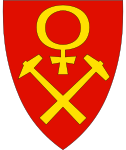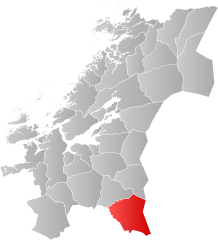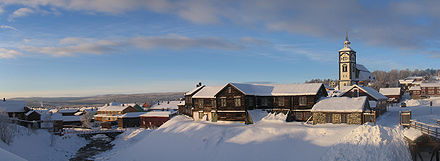Røros
| coat of arms | map | |
|---|---|---|

|
|
|
| Basic data | ||
| Commune number : | 5025 | |
| Province (county) : | Trøndelag | |
| Coordinates : | 62 ° 34 ′ N , 11 ° 22 ′ E | |
| Height : | 630 moh. | |
| Surface: | 1,956.46 km² | |
| Residents: | 5,581 (Feb 27, 2020) | |
| Population density : | 3 inhabitants per km² | |
| Language form : | neutral | |
| Website: | ||
| traffic | ||
| Railway connection: | Rørosbanen | |
| politics | ||
| Mayor : | Isak Veierud Busch ( Ap ) (2019) | |
| Location in the province of Trøndelag | ||

|
||
Røros ( ) is a mountain town in the municipality of the same name in the Central Norwegian Fylke Trøndelag near the border with Sweden . Copper ore was mined here from the middle of the 17th century until the 1970s , which has greatly shaped the appearance of the city. The old structure still largely preserved Røros has an entry on the World Heritage List of UNESCO introduced.
geography
Røros is Norway's only mountain town. It is located at an altitude of 630 meters, approx. 380 km north of Oslo and 155 km southeast of Trondheim, not far from the border with Sweden. Mountains, rivers, lakes and moors in the area characterize the landscape and offer travelers a good opportunity to pursue outdoor activities such as fishing or hiking.
This municipality is known for its harsh climate. With a record of -50.4 ° C in 1914, Røros is one of the coldest places in Norway.
history
Until the middle of the 17th century, the area of today's Røros was densely forested and home to possibly 6–7 families or 10–15 people, who lived from agriculture as well as from hunting and fishing.
It is said that Hans Olsen Aasen accidentally found the first ore while hunting in 1644, which is the beginning of the city, whose eventful history was shaped by copper ore for 333 years. Hans Aasen is therefore considered the “father” of the city and his Aasen Gard (Eng. “Aasen-Hof”) is the oldest building in Røros and is not far from the church. However, there are some indications that the ore was already being mined around 1620 or 1630.
In any case, the first mine in Røros was officially opened in 1644 by Lorentz Lossius (1589–1654) from Lommatzsch in Saxony . It is believed that by this time he had been operating this mine illegally for several years. In 1645 he started with the second mine and in 1646 the first smelter went into operation. The first river regulation was also carried out during this period. In 1651 the first church was consecrated not far from the present one.
Because Norway had no mining tradition of its own, miners from all over Europe - including the Harz Mountains - were brought to Røros, who dug the pits in Storvola . You and the name of the first engineer, Oskar Schwartz from Germany, are probably responsible for the corruption of the name Storvola in " Storvarts ". In the following centuries a number of other mines such as Hestkletten , Christianus Quintus , Nyberget and Olavsgrube were built . The latter can still be visited today.
During the 17th and 18th centuries, Røros and the surrounding pits were burned down and rebuilt several times during armed conflict with Sweden.
A reasonably accurate census in Denmark-Norway from 1769 showed that around 2000 people lived in Røros at that time. More than half of them were miners with their families. Most of the rest were farmers who earned extra income in the copper works. The mines had their own priest, doctor and school for the few craftsmen who were largely dependent on the work.
The relatively large, octagonal church was built in the years 1779–1784. It can be seen as a sign of the economic boom of the mining and smelting operations in the 18th century. While a miner earned around 50 Reichstaler a year, the construction of this church cost 23,000 Reichstaler. Today it is Norway's third largest church with 1,640 seats after the church of Kongsberg and Nidaros Cathedral .
The construction of the Røros Railway , which connects the mountain town with Oslo (then "Kristiania") and Trondheim, began in 1877. After the Kuråsfossen power station went into operation in 1896, Røros was the third city in Europe to have electric street lighting , following Paris and Hammerfest .
In 1936 the last ore field was discovered for the time being. The mine that went into operation there in the following years is called Olavs-Grube, named after the then Crown Prince Olav . After the smelter burned down for the third time in 1953, it was finally abandoned. From that point on, the ore was shipped to Boliden in Sweden for further processing. In 1977 Røros Kobberverk A / S declared bankruptcy and ended the 333 year old mining tradition with the closure of the last mine.
Two years later, the Olavs Pit was opened to visitors, and in 1981 King Olav V opened the Pit Museum there. In this context, this pit was given the new name “Crown Prince Olav Grube”. In 1980 UNESCO added Røros to the World Heritage List and ten years later the Røros Museum opened its doors for the first time in the newly built smelter.
Attractions
| The mining town of Røros and the surrounding area | |
|---|---|
|
UNESCO world heritage |
|

|
|
| Røros Kirke |
|
| National territory: |
|
| Type: | Culture |
| Criteria : | (iii) (iv) (v) |
| Surface: | 16,510 ha |
| Buffer zone: | 481,240 ha |
| Reference No .: | 55bis |
| UNESCO region : | Europe and North America |
| History of enrollment | |
| Enrollment: | 1980 ( session 4 ) |
| Extension: | 2010 |
The slag heap and smelter, which now houses the mining museum, in the middle of Røros are witnesses of a very busy time. In the past, the “Malmplass” (German: ore square) in front of the smelter was the center of the village: this is where the ore that was delivered was weighed and the bell - now a kind of symbol of the city - that rang at the beginning and end of the shift.
At the foot of the slag dumps, the small, flat, up to 250-year-old wooden houses of the simple miners still stand today. The rust-red or yellow-painted buildings for the directors, engineers and officials, which are typical for Norway, are further down in the city.
Røros is dominated by the white octagonal church from 1784, the building material of which was stored on the terraces that are still visible today. The miner's symbols chisel and mallet are affixed to the bell tower. The interior of the church is characterized by open and closed galleries and the royal box. On the walls there are pictures of pastors and mine directors from the past centuries. The church also houses a baroque organ.
Not far from the church you can find the memorial for the first ore find, as well as the Bergmannsgate and the exhibition of the historical collection of the copper works. Among other things, mining tools, lamps and flags, but also the weapons of the miners' corps, can be seen here.
A few kilometers outside the village you can visit the Olavsgrube. In the summer months there are regular tours in Norwegian and English through part of the very extensive tunnel system.
On the penultimate Tuesday in February, Rørosmartnan starts , a large market that lasts five days and attracts 70,000 to 80,000 visitors. Various goods are being sold in stalls these days. Traditional music is played in cafes and bars, and especially Rørospols .
Røros in art and in film
Fra Røros (Lillegaten) , oil painting by Harald Sohlberg from 1902 ( from Røros (side street) )
The film Nora ( A Doll's House ; directed by Joseph Losey based on Ibsen , 1973) was partly shot in Røros, as was the winter scenes in the film Pippi goes overboard (1969).
Personalities
- Ole Andreas Bachke (1830–1890), lawyer and politician
- Johan Falkberget (1879–1967), writer; his trilogy of novels Christianus Sextus (German title: "In the sign of the hammer") made the city and the lot of its miners known
- Paal Brekke (1923–1993), writer, poet, critic and translator
- Arne Skjølsvold (1925–2007), archaeologist and friend of Thor Heyerdahl
- Helge Sten (Deathprod) (* 1971), jazz and rock musician and music producer
- Håvard Augensen (* 1980), handball player
- Therese Johaug (* 1988), cross-country skier
Web links
- Tourist Information
- Very detailed website about the history of Røros
- World Heritage Site Røros
- Røros on the UNESCO website
- Tourist Office Norway
Individual evidence
- ↑ Statistisk sentralbyrå - Befolkning
- ↑ Volker Seresse: The immigration of German miners and smelters to Norway in the 17th century and their importance using the example of the Røros copper mine. In: Hans-Heinrich Hillegeist and Wilfried Ließmann (eds.): Technology transfer and emigration in the area of the Harz mining industry (= Harz research, volume 13). Verlag Lukas, Berlin 2001, pp. 49-70, ISBN 3-931836-56-8
- ^ A Doll's House (locations) . Internet Movie Database , accessed May 22, 2015 .
- ↑ Pippi disembarks (filming locations) . Internet Movie Database , accessed May 22, 2015 .







